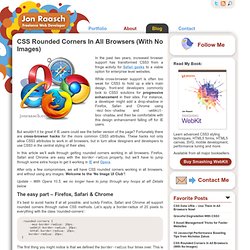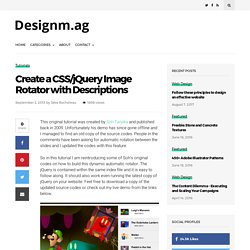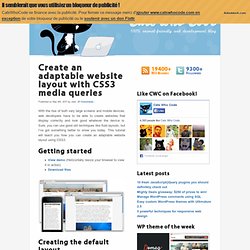

CSS Rounded Corners In All Browsers (With No Images) In the past two years, increased browser support has transformed CSS3 from a fringe activity for Safari geeks to a viable option for enterprise level websites.

While cross-browser support is often too weak for CSS3 to hold up a site’s main design, front-end developers commonly look to CSS3 solutions for progressive enhancement in their sites. For instance, a developer might add a drop-shadow in Firefox, Safari and Chrome using -moz-box-shadow and -webkit-box-shadow, and then be comfortable with this design enhancement falling off for IE users. But wouldn’t it be great if IE users could see the better version of the page? Fortunately there are cross-browser hacks for the more common CSS3 attributes. These hacks not only allow CSS3 attributes to work in all browsers, but in turn allow designers and developers to use CSS3 in the central styling of their sites.
In this article we’ll walk through getting rounded corners working in all browsers. The easy part – Firefox, Safari & Chrome. Stopping the CSS positioning panic (Part 2) - The CSS Blog, just CSS. (Tips, Tricks, Tutorials, Resources and more!) The Ultimate Collection of CSS3 Tutorials for Developers. CSS and CSS3 are dynamic to web designing and development. There was a time when developers used complex CSS codes to create a simple design element. Cascading Style Sheets (CSS) is a style sheet format, endorsed by the World Wide Web Consortium (W3C) that works with HTML documents using simple syntax and various style properties denoted by English language keywords. Most web browsers support CSS3 as it becomes more popular and more web designers implement the use of CSS3 in their layout design.
Web designers and web developers CSS3 can find valuable employment all over the world. So today, in this post I have collected some useful and fresh CSS3 tutorials for developers and designers. 1. Dark Menu: Pure CSS3 Two Level Menu 2. CSS3 Minimalistic Navigation Menu 3. CSS3 Dropdown Menu 4. Create an Image Rotator with Description (CSS/jQuery) - Web Design Blog – DesignM.ag. This original tutorial was created by Soh Tanaka and published back in 2009.

Unfortunately his demo has since gone offline and I managed to find an old copy of the source codes. People in the comments have been asking for automatic rotation between the slides and I updated the codes with this feature. So in this tutorial I am reintroducing some of Soh’s original codes on how to build this dynamic automatic rotator. The jQuery is contained within the same index file and it is easy to follow along. It should also work even running the latest copy of jQuery on your website. Create Your Own @font-face Kits. Stopping the CSS positioning panic (Part 1) - The CSS Blog, just CSS. (Tips, Tricks, Tutorials, Resources and more!) Note: This article is meant for CSS beginners. For quite some time I’ve been noticing that when my friends begin to dig their noses on CSS they are easily freaked out and frustrated with CSS positioning.
Static, relative, absolute, fixed, float. What the hell is all this! I visited Twitter to see if this was a general concern among CSS Beginners and I found that it actually is. Here are some tweets over the last week related to this subject: Create an adaptable website layout with CSS3 media queries. Getting started Creating the default layout The first step of this tutorial is obviously to create a HTML page.

I chose to make a simple HTML5 page with only a header image, a title, and some text. Copy the following code and paste it into a file named index.html. <! CSS Lifted corner Drop Shadow. CSS Techniques I Wish I Knew When I Started Designing Websites. Dec 18 2009 By Tim Wright and TJ Kelly CSS is the best thing to happen to the web since Tim Berners-Lee.

It’s simple, powerful, and easy to use. But even with all its simplicity, it hides some important capabilities. Ask any designer, and they’ll tell you that the majority of their code headaches are caused and ultimately solved by CSS. All designers at some point in their career go through the process of encountering a weird display issue, searching for a resolution, and discovering a trick, technique, or hack could have saved them hours of frustration—if they had only known when they started. We’ve put together a list of the most frustrating and time-consuming CSS headaches and, more importantly, their solutions (along with examples and further resources).
Resets & Browser Inconsistencies Not all browsers are created equal. The early stages of resets, designers dealt with differing margin and padding values, using a global reset: inputbuttonhr Resources for Resets Extras Floats & Clearing <!